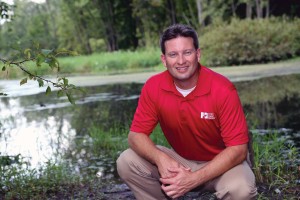
Long after Toledo’s water supply was cut for days in August 2014, researchers such as Jay Martin have continued to work to improve water quality throughout Ohio. (Photo: Ken Chamberlain, CFAES.)
Field to Faucet was conceived by The Ohio State University College of Food, Agricultural, and Environmental Sciences. The college invested $1 million toward the effort after dangerous microcystin levels in Lake Erie shut down Toledo’s water supply for two days in August 2014.
Headed by Jay Martin, an ecological engineer in the college, Field to Faucet seeks to ensure safe drinking water while maintaining an economically productive agricultural sector. The goal is to reduce nutrient runoff and protect downstream ecosystems and water quality, helping farmers increase crop yields at the same time.
The initiative involves researchers from multiple colleges within Ohio State, as well as from other Ohio universities. Current research projects supported by Field to Faucet include a tri-state, cost-share program to help protect water quality in Ohio’s Western Lake Erie Basin, as well as the development of a weather-risk-management tool to warn farmers of impending storms to help lessen the risk of runoff from nutrient application.
“There continues to be pressure on farmers to be good stewards of our water resources,” said Scott Beck, president of Beck’s Hybrids, a partner on Field to Faucet. “Beck’s and the College of Food, Agricultural, and Environmental Sciences are conducting joint research to monitor water quality in different cropping scenarios over time. We are also looking at other agronomic studies such as fertilizer utilization and tile spacing.”
Essentials
Field to Faucet projects currently underway include:
- Developing an app for farmers to record nutrient application rates and methods.
- Developing a controlled-access, geospatial-data warehouse that allows producers and researchers to secure and share publicly available data.
- Finding ways to best remove phosphorus and nitrogen from manure and anaerobic digester discharge before the materials are applied to fields. This effort will especially benefit the watershed around Grand Lake St. Marys in western Ohio.
- Using unmanned aerial vehicles to provide real-time data on concentrations of microcystin created by harmful algal blooms in Lake Erie; and developing a sensor to detect real-time concentrations of microcystin in the lake.
Learn more about Field to Faucet here.
